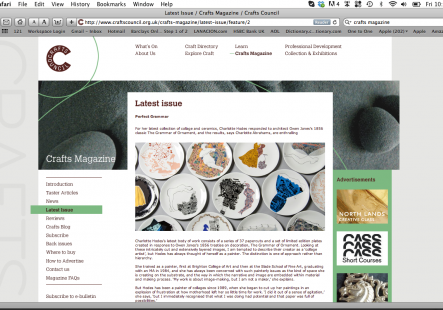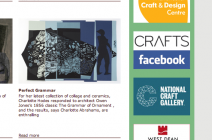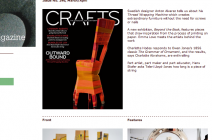Charlotte Hodes - The Grammar of Ornament in Crafts Magazine
07/03/2014
Charlotte Hodes - The Grammar of Ornament in Crafts Magazine
Perfect Grammar
For her latest collection of collage and ceramics, Charlotte Hodes responded to architect Owen Jones’s 1856 classic The Grammar of Ornament, and the results, says Charlotte Abrahams, are enthralling
Charlotte Hodes’s latest body of work consists of a series of 37 papercuts and a set of limited edition plates created in response to Owen Jones’s 1856 treatise on decoration, The Grammar of Ornament. Looking at these intricately cut and extensively layered images, I am tempted to describe their creator as a ‘collage artist’, but Hodes has always thought of herself as a painter. The distinction is one of approach rather than hierarchy.
She trained as a painter, first at Brighton College of Art and then at the Slade School of Fine Art, graduating with an MA in 1984, and she has always been concerned with such painterly issues as the kind of space she is creating on the substrate, and the way in which the narrative and image are embedded within material and making process. ‘My work is about image-making, but I am not a maker,’ she explains.
But Hodes has been a painter of collages since 1989, when she began to cut up her paintings in an explosion of frustration at how motherhood left her so little time for work. ‘I did it out of a sense of agitation,’ she says, ‘but I immediately recognised that what I was doing had potential and that paper was full of possibilities.’
The Grammar of Ornament series, which will be shown at London’s jaggedart gallery from 6 March – 5 April, is a celebration of those possibilities. Each work is Hodes’s instinctive response to Owen Jones’s 37 Propositions for the ‘arrangement of form and colour in architecture and the decorative arts’. Number one, for example, states that the ‘Decorative Arts arise from, and should properly be attendant upon, Architecture.’ While number eight pronounces that ‘all ornament should be based upon a geometrical construction.’
‘I was excited by the rigidity of the Propositions,’ she says, ‘because of the potential to mess them up.’
Hodes is a surprisingly subversive artist. She is instinctively driven to disrupt patterns (despite her life-long passion for textiles, she knows she could never make them because she couldn’t stick to the strict rules governing pattern repeats), and her work is composed of fragments of images which she has generated herself by manipulating existing swatches on the computer. For instance, the floral background on Architecture, the papercut she made in response to the first proposition, is a digitally manipulated scan of a fabric swatch from the Hayes Textile Ltd. collection, which she came across in the archives at the London College of Fashion, where she is professor in fine art.
More subversive still is Hodes’s career-long interest in decoration, the seeds of which were sown in the male-dominated world of the Slade’s painting department in the early 80s. ‘I have taken a difficult route,’ she says. ‘Decoration was shunned when I was a student, especially when created by a woman. In the early 80s, female artists were supposed to be menstruating in a box or something, rather than making work which was concerned with the decorative and the domestic – but I have always been very conscious that the decorative arts are a serious art form and that one can say something important about their relationship with fine art within that arena.’
The Grammar of Ornament series is a continuation of that discourse. Jones’s book has been a seminal work for artists, designers and architects from Christopher Dresser to Le Corbusier, and through her series of intensely decorative, jewel-like papercut responses to his Propositions, Hodes is once again causing us to question the rigid hierarchies present in the world of the visual arts.
The new works are also an extension of her long-standing involvement in a discussion about how the decorative arts relate to the female experience. Much of her previous work has featured a female figure, usually depicted in outline only, walking left to right across the picture plane. This woman appears in each of the 37 Grammar of Ornament papercuts, sometimes barely discernible amid the surrounding pattern, but always an assertive and disruptive presence. ‘The Propositions didn’t invite the female gaze at all, which was one of the attractions,’ Hodes says. ‘I wanted to feminise this Victorian classification, and to confront concepts of idealised beauty, and the way in which the female figure has traditionally been depicted as both a decorative and domestic goddess.’
It is subtly done. Interstices is the papercut corresponding to Proposition seven (‘The general forms being first cared for, these should be subdivided and ornamented by general lines; the interstices may then be filled in with ornament, which may again be subdivided and enriched for closer inspection’). In it, the female protagonist stands on a delicate pink background cut to resemble lace. The shape of her dress suggests a 50s frock. On either side stand sections of columns composed from fragments of floral patterns or architectural details. The one on the left is pink. The edge of the piece is a frill. The overall effect is pretty, decorative and rather traditionally feminine.
‘I wanted to create something pretty and feminine,’ Hodes says, ‘and I wanted the figure to be delicate and fragile but, crucially, I also wanted to convey the sense that she is there on her own terms. She has chosen to be there; she has allowed herself to be gazed at but only for as long as she determines. The work is saying that women can be feminine and pretty in an empowering way. I think that is a significant thing to say.’
Hodes has also always been acutely conscious that the female domain is domestic, and continues here to explore her career-long belief that a reappraisal of the decorative arts is seminal to the understanding of the lives of women. Domestic references appear again and again – there are vessels and vases (sometimes, as in Proposition 25 Lethargy, shown actually supporting the female figure), a skirt taken from a paper pattern (Proposition 27 Hidden) and zigzag edges which create the effect of a dressmaker’s pinking shears (Proposition eight Geometry). And there are the plates; 37 different designs, each corresponding to a papercut, and each one available as a limited edition of 100. ‘I love the idea that plates have a narrative that is domestic,’ she explains, ‘and on each of them, I have deliberately shown the woman in repose – her idleness is a challenge to traditional female responsibilities, such as serving the food and doing the dishes.’
Hodes’s work wears its message lightly. The plates make you smile – those languid women not only challenge gender roles but, less seriously, are an ironic comment on the labour involved in their creation. (The plates themselves were supplied by Wedgwood, but the 3,700 images are a combination of digital transfers, screenprints and painstakingly applied hand-cuts.)
And everything on show at jaggedart is beautiful. In the catalogue, artist and writer Dr Janet McKenzie states that Hodes’s work is a ‘pragmatic assertion of the important yet threatened English tradition of decorative arts and of female independence in the art world,’ and indeed it is, but standing in Hodes’s utilitarian East London studio surrounded by her papercuts and plates, my overriding impression is one of beauty. I hesitate before voicing this thought because ‘beautiful’ can be a difficult term for painters, but Hodes seems to accept the description. ‘I think my six years at the London College of Fashion have done me good,’ she says. ‘It’s a very female environment and being a college of fashion, it’s one in which beauty is celebrated. This work is inspired by my responses to Jones’s Propositions, but also to the 100 intensely decorative colour plates in the book. I wanted my papercuts to capture that jewel-like quality.’
Jones’s book is well known in the design world, but many visitors to this show will not be familiar with the Propositions themselves. When we met, Hodes was still trying to decide whether to display the Propositions in the gallery (they are in the catalogue, but together at the front rather than alongside each corresponding papercut). On the one hand, she wants viewers to understand where the idea for each image came from, but she’d rather they discovered the connections for themselves. This quiet approach is characteristic: Charlotte Hodes may have spent her career challenging the art world, but she has never been a shouty painter. Her work is subtle and its message requires and rewards long contemplation. Make time for this show; it is both thought provoking and beautiful. Owen Jones should be flattered.
The Grammar of Ornament: New Papercuts and Ceramics is at jaggedart, 28a Devonshire Street, London W1, from 6 March – 5 April 2014.



